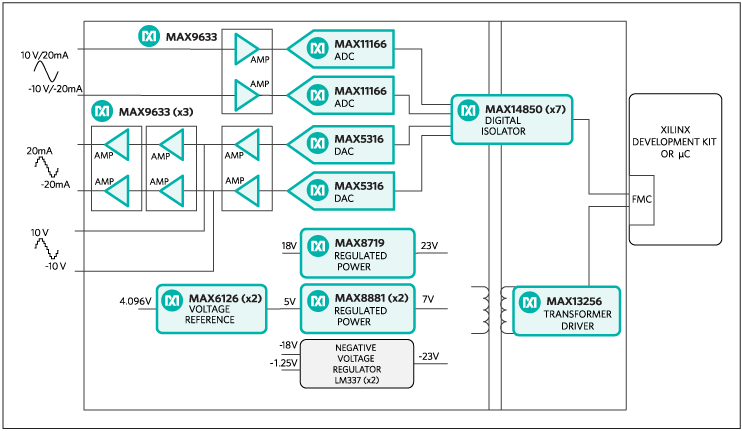Overview
設計リソース
説明
Advanced manufacturing, custom production and cost pressures continue to drive factories to higher speed performance and increased flexibility. To meet the requirements of a ‘no compromises’ factory environment, the MAXREFDES71 subsystem reference design provides two high-speed, high-accuracy, 400ksps, 16-bit analog input channels and output channels. All input and output channels support ±10V and ±20mA signals plus 20% margin, providing flexibility for low- and high-speed systems using either voltage or current signals.
The MAXREFDES71 design utilizes four dual fast-settling high-voltage op amps (MAX9633); two 16-bit 500ksps ADCs (MAX11166); two low-noise, fast-settling precision 16-bit DACs (MAX5316); two ultra-high precision 4.096V voltage references (MAX6126); seven high-speed digital isolators (MAX14850); an H-bridge transformer driver for isolated supplies (MAX13256); and regulated +18V, -18V, +5V, and -1.25V power rails (MAX8719, MAX8881). By using high-accuracy and high-speed components, this subsystem performs well in both process control applications, such as sensor inputs, and control applications, such as servo drives, resolvers, and encoders.
機能と利点
Applications
- Industrial control automation
- Servo drive
Competitive Advantages
- High speed
- High accuracy
- Low noise
Features
- Two independent analog inputs
- Two independent analog outputs
- Isolated power and data
- High-speed 400ksps analog input sampling rate
- High-accuracy 16-bit resolution
- Voltage output settles to within 2 LSB in 17µs
- Current output settles to within 2 LSB in 77µs
- Device drivers
- Example C source code
- Configuration files for ZedBoard™ platform
- FMC-compatible
Details Section
Documentation & Resources
-
MAXREFDES71 Design FIles2021/02/17ZIP26 M
-
UG-5866: MAXREFDES71# ZedBoard Quick Start Guide2014/06/27PDF2M
Support & Training
Search our knowledge base for answers to your technical questions. Our dedicated team of Applications Engineers are also available to answer your technical questions.













